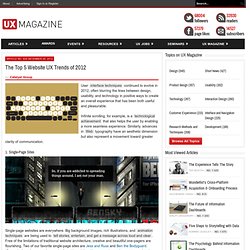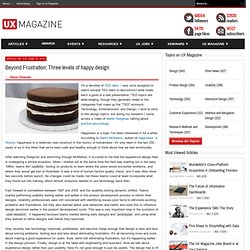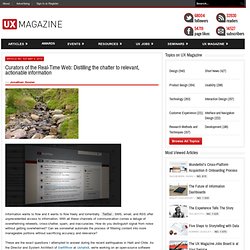

The Top 5 Website UX Trends of 2012. User interface techniques continued to evolve in 2012, often blurring the lines between design, usability, and technology in positive ways to create an overall experience that has been both useful and pleasurable.

Infinite scrolling, for example, is a technological achievement that also helps the user by enabling a more seamless experience. Similarly, advances in Web typography have an aesthetic dimension but also represent a movement toward greater clarity of communication. 1. Single-Page Sites Single-page websites are everywhere. 2. Infinite scrolling is familiar to everyone, even if they don't realize it. 3.
Persistent menus are ideal for complex sites, long scrolling pages, or applications with toolbar functionality. 4. We've noticed a return to basics in visual design trends. 5. Thanks to maturing font technologies and improved font rendering on most browsers and devices, designers have more typefaces to choose from and more control of their type. Beyond Frustration: Three levels of happy design. I'm a devotee of TED talks.

I was once assigned to watch several TED talks to deconstruct what made each a good or a bad presentation. TED topics are wide-ranging, though they generally relate to the categories that make up the "TED" acronym: Technology, Entertainment, and Design. I tend to stick to the design topics, but during my research I came across a video of Martin Seligman talking about positive psychology. Happiness is a topic I've been interested in for a while.
According to Darrin McMahon, author of Happiness: A History, happiness is a relatively new construct in the history of humanness. After watching Seligman and skimming through McMahon, it occurred to me that the experience design field is undergoing a similar evolution. Fast forward to somewhere between 1997 and 2005, and the usability testing dynamic shifted. It seems we're all aspiring to an ideal of designing for delight, but most of us are landing somewhere short of delight, but at least better than frustrated. Curators of the Real-Time Web. Information wants to flow and it wants to flow freely and torrentially.

Twitter, SMS, email, and RSS offer unprecedented access to information. With all these channels of communication comes a deluge of overwhelming retweets, cross-chatter, spam, and inaccuracies. How do you distinguish signal from noise without getting overwhelmed? Can we somewhat automate the process of filtering content into more manageable portions without sacrificing accuracy and relevance? These are the exact questions I attempted to answer during the recent earthquakes in Haiti and Chile. The approach SwiftRiver takes is to combine crowdsourced interaction with algorithms that weight, parse, and sort incoming content. User Experience and Real-Time Content As we move into the future of the Web, it's clear that real-time content is going to remain an increasingly important part of our online experience.
The layout of google.com is often cited as a good example of simplexity. The Existing Workflow Curating Reputation. Social Design Strategy. Great products and services depend on their users having great experiences.

But it’s not about what users do or how they do it, but rather why. Why they do what they do, why they keep coming back, and why they tell their friends. And social design aims to explain the why behind great experiences. I’ll tell you a quick story. Strand Book Store in NYC is apparently very famous, but I had never heard of it (and I’m from the New York area, too) until earlier this year when I was walking around with a friend and she pointed it out to me.
That story in and of itself is not a big deal. In these cases and when we are faced with more subjective questions such as, “Where’s a good Italian restaurant?” Communities are very useful. And though we have all kinds of relationships in our lives—with coworkers, neighbors, or brands, and long lasting or short lived, formal or intimate—it’s with our strongest ties that our trust lies. Trust is built through this conversation. Building Conversation Listening.